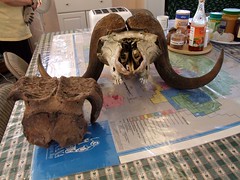Male dinosaurs probably sat on nests and cared for young, new analyses of fossilized eggs and bones suggest. The results, published by paleontologist David Varricchio and colleagues in the Dee. 19 Science, indicate that the parental division of labor of some modern-day birds may have first evolved in the birds' dinosaur ancestors.
"I think it's more interesting than the authors know. This answers all sorts of questions about bird behavior" says Yale University ornithologist Richard Prum.
[ILLUSTRATION OMITTED]
Large, generally flightless birds called ratites, which include emus, ostriches and rheas, are closely related to dinosaurs. Males of these avian groups shoulder the bulk of childcare responsibilities. Ratite fathers incubate eggs, defend the nest from predators and look out for the hatchlings. What's more, morn and dad share child-rearing duties in about 90 percent of bird species alive today.
Fossils of adult Troodon, Oviraptor and Citipati dinosaurs--all meat-eating, bipedal theropods--have been found on or near a clutch of eggs. Some adults were even caught in a brooding position (like a sitting hen), raising suspicions that the adults died in the act of caring for the brood. But scientists didn't know whether the adults sitting on the nest were fathers or mothers.
Varricchio's team found no female-specific markings on bones from two adult dinosaurs: a Citipati, fossilized in the brooding position on a clutch of eggs, and a Troodon, fossilized while at a nest site. Many female birds have medullary bone, a spongy, disordered layer lining the insides of long bones, probably serving as a nutrient source while the female formed eggs. Medullary bone has also been found in Tyrannosaurus and Allosaurus species.
The absence of this female-specific marker in the Troodon and Citipati bones led Varricchio, of Montana State University in Bozeman, to conclude that these two adults were most likely males. Varricchio notes that figuring out a dinosaur's sex is tricky, and the absence of the medullary bone layer, while a good argument for maleness, is not conclusive.
The researchers also compared the size and number of fossilized eggs, from 22 to 30 large eggs per clutch, with those in nests of modern birds. The unusually large size of the dinosaur clutches was similar to the clutches of birds that exhibit paternal care. Both the large clutch size and the malelike bones of adult dinosaurs make it likely that dinosaur dads looked after the kids, the team reports.
Sanders, Laura
Source Citation
Sanders, Laura. "Dinosaur dads as caretakers: fossilized bones near nests probably came from males." Science News 17 Jan. 2009: 14. General Science Collection. Web. 22 Mar. 2012.
Document URL
http://go.galegroup.com/ps/i.do?id=GALE%7CA192485357&v=2.1&u=22054_acld&it=r&p=PPGS&sw=w
Gale Document Number: GALE|A192485357


No comments:
Post a Comment